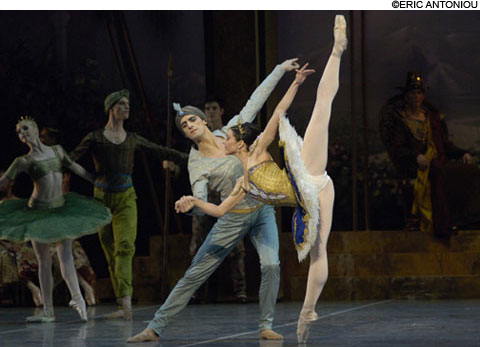
FORGET THE RICH BITCH Kathleen Breen Combes (here with Lasha Khozashvili) was slinky and sensational as Gamzatti. |
For a classic Russian ballet that debuted the same year as Swan Lake, La Bayadère — "The Temple Dancer" — has always gotten short shrift in Boston. Anna-Marie Holmes staged it for Boston Ballet in 2000, in what seems to have been the company's first performance of this exotic work. It was announced as Boston Ballet's finale for the 2007–2008 season, but the production that artistic director Mikko Nissinen wanted proved unavailable, so the company did Swan Lake instead. Now it's finally here, in what, as staged by former Paris Opera Ballet étoile Florence Clerc, amounts to the production Rudolf Nureyev did for Paris, complete with temple dancers, holy fakirs, tiger hunters, a rajah and his daughter, a high brahmin, and, oh yes, a papier-mâché elephant. Highlighted by a slinky Kathleen Breen Combes as Gamzatti, the Ballet's opening-night performance confirmed that La Bayadère should visit the Hub more often.
The story is a ballet staple: a boy, a girl, and . . . another girl. Think James torn between Effie and the Sylphide in La Sylphide, Albrecht caught between Giselle and Bathilde in Giselle, Frantz deserting Swanilda for Coppélia in Coppélia, Siegfried mistaking (?) Odile for Odette in Swan Lake. Here, it's the warrior Solor who's in romantic straits: no sooner does he fall in love with the temple dancer Nikiya than the Rajah decides our hero is the one to marry the royal daughter, Gamzatti. Solor is flattered, Gamzatti is beautiful, and the Rajah is not to be trifled with. What will Solor do? We never really find out, because there's a complication. The High Brahmin is also in love with Nikiya, but she's rejected him. (Whether that's because one or both of them is supposed to have taken a vow of chastity is not clear.) When he spies Solor and Nikiya plighting their troth over the Sacred Fire, he goes to the Rajah and tattles. You might wonder why, with Solor now engaged to Gamzatti, the High Brahmin wouldn't leave well enough alone. And indeed, the Rajah's solution is not to kill Solor but rather to have Nikiya eliminated. That's not the end of Nikiya's problems: after Gamzatti overhears the conversation between the High Brahmin and her father, she has Nikiya called in and tries to buy her rival off with a bracelet and then a necklace. When Nikiya refuses, Gamzatti too decides that the temple dancer must die.
The upshot is that, in act two, as an anguished Nikiya is ordered to dance in celebration of the royal engagement, she's bitten by a snake that was hidden (by the Rajah, perhaps with Gamzatti's approval) in a basket of flowers she'd been given. The High Brahmin offers her an antidote, but Nikiya decides she prefers death to life without Solor. Distraught, Solor resorts to opium, and that brings us to the third act, the celebrated "Kingdom of the Shades," which opens with a procession of tutu'd shades (here 24) descending a zigzag ramp in a hypnotic alternation of arabesque and tendu. Once they're assembled on the stage floor, Nikiya and Solor appear and dance into eternal bliss.